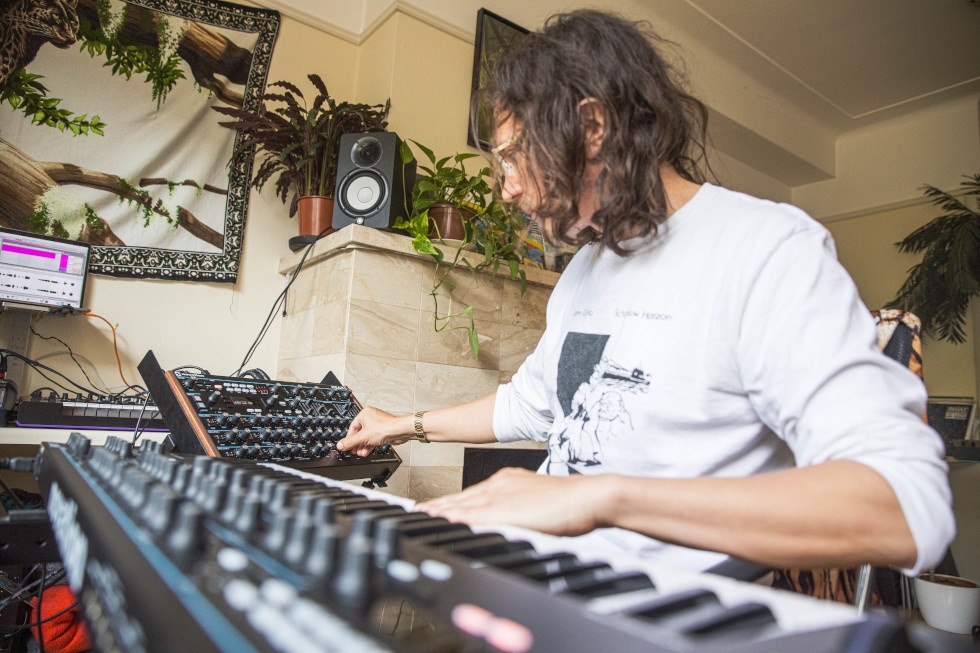Introducing Synth Snackables // Peak: Legowelt
Our Synth Snackables series invites you into the studios of talented and knowledgeable artists, and shows you staple tips, elaborate techniques and imaginative approaches for synth patch design.
For our first Synth Snackable session, we spent a day with Dutch artist Legowelt whose vast musical style spans many different worlds – some real, some imagined – and is designed in a unique and captivating way that keeps his listeners enthralled. His wealth of production knowledge and experience have been turned into five quick tips to help you push the boundaries of Peak.

Peak: fun with envelopes
“The cool thing about the Peak is that you can assign both envelope generators” – Legowelt
Legowelt explains that negative envelope depth is essentially like “inverting” the envelope. Showing how you can use them to create “springy” effects that sound organic. He assigns both a positive and negative mod envelope depth to the analogue filter – creating an eight-point filter envelope that sounds joyful yet eclectic as they both battle for control.
“You can go really deep with it.” Using the envelope generator menu, Legowelt loops individual envelopes, controls the repeat and hold time to expand functions of the generators beyond ADSR - giving him more fluid and detailed control of filter envelope movement. By experimenting, playing and assigning these to other parameters Legowelt unlocks the capabilities of Peak.
Peak: as a drum machine
“The really cool thing about Peak is that you can modulate the keyboard to a lot of functions” – Legowelt
Starting by maxing out filtering resonance, negating depth and assigning his SL MkIII keyboard as the destination, Legowelt shows how you can quickly build a staple drum kit with Peak. With the lower octaves acting as his bass, Legowelt creates snares and high hats with the higher octaves using the noise level.
“So now we have this drum kit but there’re a lot of fun things we can do.” Using the arpeggiator to start the rhythm, Legowelt uses the Peak like a drum-machine. By adding distortion, reverb and changing the filter envelope he easily creates a “unique drum sound.” Bringing groove to the loop with delay, adding a “hypnotic techno” melody by detuning oscillators and showing off filter overdrive - Legowelt creates an advanced drum loop that morphs organically, demonstrating how this tip can become fundamental to any live setup.
Peak: as a hurdy gurdy
“The cool thing about Peak is that it has fixed note in the oscillators” – Legowelt
Beginning with the basis of the hurdy gurdy, Legowelt puts Peak into monophonic mode and assigns the fixed note function to play the same note with two oscillators. Now with the third oscillator free to play a higher note, Legowelt shows how you can quickly create a “jolly” medieval drone.
“Of course we can make it much more interesting.” Creating movement with filter envelopes, adding multiple LFO modulation and assigning pitch range to the two oscillators, Legowelt shows you can build on the basic hurdy gurdy to create a deepened historical-inspired melody.
Peak: delay as a looper
“Peak has a really nice delay effect” – Legowelt
Suggesting that you start with a rhythmic sound to get a feel for the groove, rhythm and timing, Legowelt adds delay on a short staccato bass and maxes out level, time and feedback to start the loop. Relying on intuition and spontaneity, he shows how adding LFO, chords, melodies, effects and more creates an ever-evolving soundscape.
Legowelt also explains that using this tip isn’t an endless looper and that old sounds are replaced by anything new over time – “it does it in a really nice way almost like a tape loop that’s disintegrating.” This tip allows for an infinite number of layers to be played over the top, allowing you to create entire tracks in real time.
Peak: three-oscillator harmonics
“You can detune each pitch of the oscillator into different notes” – Legowelt
Highlighting an essential synth tip for creating harmonic sounds, Legowelt detunes each oscillator pitch with the coarse function to create a minor triad. By simply playing other keys polyphonically and opening the sound up with envelopes, he creates a deep dreamy soundscape.
“I haven’t even changed the waveforms and the Peak has an amazing amount of waveforms.” Legowelt shows how you can add richness and depth to the chord by changing the waveforms of the oscillators and adding LFO. He also demonstrates a more advanced tip that involves detuning two oscillators so that they play discretely – an effective way to simulate acoustic instruments and add harmonic character.
Legowelt’s style comes from an unfaltering devotion to hardware, be it old, new or totally knackered. Jamming all day long on music making toys, his output veers from dense and forestry techno to whizzing electro, deeper electronic and genres for which there isn't even a name yet. His patches from this Synth Snackable session are available for Peak and Summit as a free download through the Novation Components app.

